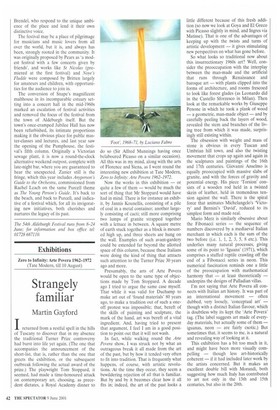Strangely familiar
Zero to Infinity: Arte Povera 1962-1972 (Tate Modern, till 10 August)
Martin Gayford
Ireturned from a restful spell in the hills of Tuscany to discover that in my absence the traditional Turner Prize controversy had burst into life yet again. (The one that accompanies the announcement of the short-list, that is, rather than the one that greets the exhibition, or the subsequent outbreak following the actual award of the prize.) The playwright Tom Stoppard, it seemed, had made a time-honoured attack on contemporary art, choosing, as precedent dictates, a Royal Academy dinner to do so (Sir Alfred Munnings having once belaboured Picasso on a similar occasion). All this was in my mind, along with the arts of Florence and Siena, as I went round the interesting new exhibition at Tate Modern, Zero to Infinity: Arte Povera 1962-1972.
Now the works in this exhibition — or quite a few of them — would be much the sort of thing that Mr Stoppard would have had in mind. There is for instance an exhibit, by Jannis Kounellis, consisting of a pile of coal in a metal container; another largely consisting of cacti; still more comprising two lumps of granite strapped together with a lettuce in between. A square metre of earth stuck together as a block is mounted high up, and three sheets are hung on the wall. Examples of such avant-gardery could be extended far beyond the allotted space of this column, because these Italians were doing the kind of thing that attracts such attention to the Turner Prize 30 years ago and more.
Presumably, the arts of Arte Povera would be open to the same type of objections made by Tom Stoppard. A decade ago I tried to argue the same case myself. That while it was valid for Duchamp to make art out of 'found materials' 80 years ago, to make a tradition out of such a oneoff protest was impossible; that, bereft of the skills of painting and sculpture, the mark of the hand, art was bereft of a vital ingredient. And, having tried to present that argument, I feel I am in a good position to point out that it will not wash.
In fact, while walking round the Arte Povera show, I was struck not by what an outrageous break it all made from the art of the past, but by how it tended very often to fit into tradition. That is frequently what happens, of course, with artistic revolutions. At the time they occur, they seem a bewildering rejection of all that is familiar. But by and by it becomes clear how it all fits in; indeed, the art of the past looks a little different because of this fresh addition (so now we look at Goya and El Greco with Picasso slightly in mind, and Ingres via Matisse). That is one of the advantages of keeping up with the twists and turns of artistic development — it gives stimulating new perspectives on what has gone before.
So what looks so traditional now about this insurrectionary 1960s art? Well, consider the preoccupation with the interplay between the man-made and the artificial that runs through Renaissance and baroque art — with plants clipped into the forms of architecture, and rooms frescoed to look like forest glades (as Leonardo did in the Castello Sforzesco in Milan). Then look at the remarkable works by Giuseppe Penone in which he took a plank of wood — a geometric, man-made object — and by carefully peeling back the layers of wood, revealed the stem and branches of the living tree from which it was made, surprisingly still existing within.
The obsession with weight and mass of stone is obvious in every Tuscan and Umbrian hill town, and also the twisting movement that crops up again and again in the sculptures and paintings of the 16th and 17th centuries. Giovanni Anselmo is equally preoccupied with massive slabs of granite, and with the forces of gravity and potential energy. His piece 'Torsion' consists of a wooden rod held in a twisted skein of leather, held in tremendous tension against the wall. There is the spiral force that animates Michelangelo's 'Victory' and Bernini's 'David', reduced to its simplest form and made real.
Mario Merz is similarly obsessive about the Fibonacci series — the sequence of numbers discovered by a mediaeval Italian merchant in which each is the sum of the two before (i.e. 1, 1, 2, 3, 5, 8 etc.). This underlies many natural processes, giving some of its point to 'Iguana' (1971), which comprises a stuffed reptile crawling off the end of a Fibonacci series in neon. This numerical fascination reminds one a little of the preoccupation with mathematical harmony that — at least theoretically — underpins the designs of Palladian villas.
I'm not saying that Arte Povera all connects with Italian art history. It was part of an international movement — often dubbed, very loosely, 'conceptual art' — though with a distinct Italian flavour, which is doubtless why its kept the `Arte Povera' tag. (The label suggests art made of everyday materials, but actually some of them — iguanas, neon — are fairly exotic.) But sometimes that, it seems to me, is a natural and revealing way of looking at it.
This exhibition has a bit too much in it, and might have been more visually compelling — though less art-historically coherent — if it had included later work by the artists concerned. But it makes an excellent double bill with Morandi, both suggesting how much Italy has contributed to art not only in the 13th and 15th centuries, but also in the 20th.


































































 Previous page
Previous page